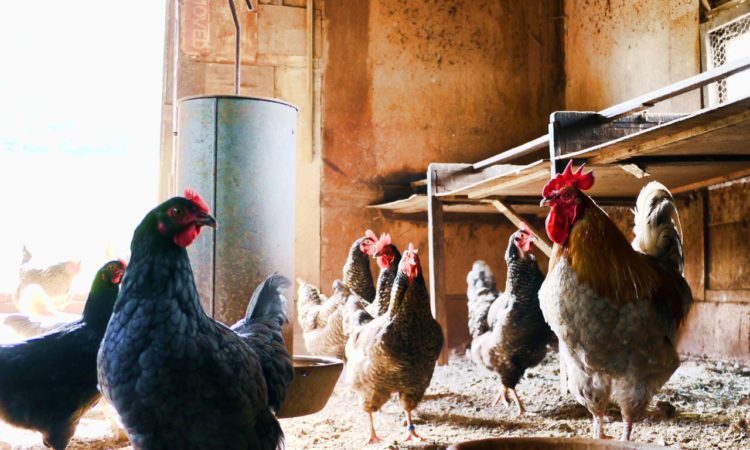Chicken Coops & Runs – Three Critical Features
THE COOP
As you’ll read on every good site, there are three critical things about chicken coops and runs:
- They both have to be predator proof!
- You want them to be large enough that you don’t have crowded, stressed chickens who are pecking at each other. (Sometimes they do anyway; see PECKING ORDER.)
- You want the chicken coop itself to be snug and draft-free, but with good air exchange. Chickens are prone to respiratory illnesses in stale, moist air.
How do you make sure your Coop is safe?
Chicken Coops & Runs: Safety First!
Anyone who hasn’t completely, thoroughly, absolutely, and positively predator-proofed their coop – and pen – will wake up to a sad scene one day (depending on your area and local predators). It won’t even be a single chicken missing, a fox having quietly carried one off. It’s more likely to be a scene of mass slaughter. Predators are just trying to make a living—they can’t go to the grocery store—but having chickens is a battle to draw a line between your desire to keep a certain group of hens safe, and a whole host of predators’ desire to secure their next meal.
First, by keeping out every creature who can SQUEEZE through a small space (a weasel), and those who can DIG (foxes), and those whose hands can figure out how to OPEN DOORS and latches (raccoons). How do you do this? Make sure you have no holes larger than ½”. Weasels can sneak through anything larger. As mentioned in the LIGHT section, if you have windows that open use sheets of ¼” hardware wire cut to size as your screens. Make sure your coop door is latched securely—especially from raccoons. A simple hook and eye is not enough. Use a bolt latch plus a carabiner and slip it through the latch. Carabiners snap closed and are fare more difficult to wrangle out of a latch, and gives the racoons’ clever hands two levels of defeat – first they have to wrangle off the carabiner, then pull back a latch.
Chicken Comfort: Space, Light, Ventilation
Square Footage of Your Coop and Run
You’ll read various numbers re: square feet needed in the coop and pen. Mary and I (our chickens, and some of our chicken-loving friends) have found that the numbers you see in most places are too low. When you’re thinking about buying or building your Coop – the enclosed place where the chickens will roost and where they’ll hang out in bad weather, try to have a minimum of 4 square feet per chicken. For 6 chickens, this means 24 square feet, or a Coop of 6’ by 4’.
Lighting and Heat Lamps
Especially in poor weather and during the shorter days of the year you want your hens to have light. Make sure you have enough windows to give them maximum light without having add electric lights. If you’re building a coop, places like shed-windows.com have aluminum/glass windows in various sizes. If you get the kind that open—and that’s best for warmer weather, so you can have a cross-breeze—they’ll have mesh screen. That isn’t strong enough to keep anybody out of your coop, so you need to put a sheet of ¼” hardware wire up inside the coop where that screen is. That hardware wire is your permanent window screen; when the window is open, nobody can get in.
Ventilation is a Must
No matter how well-sealed your coop, your chickens must also be getting fresh air. Having vents that can open and close above their roosting area can be ideal for this. Unless the weather is truly bitter, you want to leave them open enough that fresh air is getting in, and the chickens’ warm breath is able to rise and go OUT—you don’t want the Coop becoming moist from their breath.
Chicken Coops & Pens: The Run
THE CHICKEN RUN
If your chickens are going to be contained all the time, and only have their enclosed Coop plus Pen in which to live their lives, once again—the more space the better! 10 square feet per hen is minimal, so for 6 hens, you want a Pen that is at least 60 square feet, or 6’ x 10’. One way to get extra square footage for your hens and simultaneously build them a Pen that is ultra safe, is to build a Playhouse Coop, since that gives them extra room beneath the elevated Coop. Elissa used ¼” hardware wire to enclose the entire pen— creating the Fort Knox of chickens. No one can dig under, swoop down, or otherwise get to the hens when they are safely inside. They can also come in and out of their coop as they please in all weather. The door, which is wood-framed plexiglass so the hens can see through, has a very ineffective magnet on it , and that works perfectly. On winter nights Elissa gently clicks the door closed. In the morning, they hens, knowing that the door can open, give it a little push and voila! – they’re out in the secure pen, and can start their day without me.
Another idea that we used to allow chickens to have a very large run is we allow them to share the goat pen. We created a small area that allow the chickens to go in and out of their run but not big enough for our goats to break into the run and eat the chicken feed. The chickens and goats seem to enjoy each others company.

